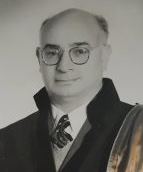Prof.Dr. Hamit Dilgan
Hamit Dilgan was born on March 18, 1901, in Istanbul. He graduated from Vefa High School in 1921. In the same year, he enrolled at Istanbul University Faculty of Science and completed his undergraduate studies in mathematics and general physics in 1924. Continuing his education for another year, he also obtained a certificate in astronomy from the same faculty. After a one-year internship in the Astronomy Department of Kandilli Observatory in 1925, he was appointed as an assistant in the observatory’s astrophysics and geophysics branches. During his service until 1932, he collaborated with Fatin Gökmen and two others, conducting research particularly in the fields of geomagnetism and seismology. From 1926 to 1934, he taught mathematics at Boğaziçi High School and in 1930, he gave lectures on astronomy and celestial mechanics at the Faculty of Science.
In 1932, Hamit Dilgan was appointed as an assistant professor (docent) of mathematics at the Higher Technical School. In 1934, he became the group instructor for general mathematics-1, analysis II, and practical applications of rational mechanics. In 1944, he was appointed as a professor of mathematics and applied mathematics at the Faculty of Architecture at Istanbul Technical University. From 1936 to 1946, he served as an instructor in general mathematics at Istanbul Technical School (later Yıldız Technical University). In 1946, he became the chair of the department and held this position until 1960. He was among the thirteen founding members of the Turkish Mathematical Society in 1948.
At Istanbul Technical University, following the intense earthquake in Erzincan in 1939, he initiated earthquake studies, leading to the establishment of the Seismology Institute in 1952 with technical assistance from UNESCO. He served as the director of the institute until 1956. During this time, he established three earthquake stations in Kastamonu, Çine, and one at Istanbul Technical University, collaborating with foreign experts. In 1954, he played a role in the founding of the Turkish Astronomical Society along with eleven others.
In the IXth International Congress on the History of Science in 1959, Hamit Dilgan was awarded the Euler Medal in honor of the renowned mathematician Leonhard Euler for his work titled “The Great Mathematician Omar Khayyam” and a paper on “Ibn al-Haytham’s Isoperimetric Problem.” He celebrated his thirtieth year in his profession at Istanbul Technical University in 1963. During the years 1966–1967 and 1968–1969, he served as the director of the Electronic Computing Center under the auspices of the rectorate. Dilgan, who also had an interest in music and poetry, was proficient in French, German, Italian, and Arabic.
Hamit Dilgan entered the world of science through his work in the field of natural sciences, but after starting to work at the Higher Technical School, he shifted his focus to the history of science. Influenced by Salih Zeki, under whom he was a student at the Faculty of Science and who aimed to reveal the extent to which medieval Islamic mathematicians developed ancient Greek mathematical knowledge, Dilgan conducted research in the field of medieval Islamic mathematics history. He continued his studies by examining the names that Salih Zeki addressed in his own research.
However, in his work, Dilgan, like his contemporary science historian Aydın Sayılı, concentrated particularly on the contributions of Turkish scientists, aligning with the nationalistic policies of the Republic of Turkey during that period. Hamit Dilgan made his first publication in the field of the history of science with the article titled “Türk ve Arap Riyâziyesi” in 1940. Following this, he published several short articles on the subject for about fifteen years. In 1955, after approximately twenty years of research, he shifted his focus to the history of science, particularly after his work titled “Matematiğin Tarih ve Tekâmülüne Bir Bakış” (A Glance at the History and Evolution of Mathematics).
Starting from 1947, he conducted history of science research in libraries in Istanbul, Alexandria, Cairo, Paris, and Rome. During his stay in Munich in 1958, he established contact with the mathematician and historian Kurt Vogel, which led him to new research. He participated in the VIIIth and IXth International Congresses on the History of Science in 1956 and 1959 with his presentations. In 1960, he conducted further research on the history of science in Paris and Munich.
Professor Dr. Hamit Dilgan passed away on November 13, 1976, in Istanbul. After the ceremony held at the Istanbul Technical University Taşkışla building on Tuesday, November 16, 1976, he was laid to rest at Feriköy Cemetery.
**This biography was compiled by our board member Özkan Değer for the booklet “TMD 75 Yılın Ardından,” prepared on the occasion of the 75th anniversary of the Turkish Mathematical Society.
